|
Navigation
LakesnWoods.com
Home
Page
Contact Us
Privacy
Lake Wilson Guide:
Photo Gallery
Location
Geography
Demographics
History
Government
Post Office
News
Weather
Street Map
Events
Attractions
Recreation
Lakes
Health Care
Schools
Churches
Media
Motels
Resorts
Campgrounds
Businesses
Aerial Photo
Topographic
Map © 2004-2025 LakesnWoods LLC
All Rights Reserved
|
WANTED! Do you have photos, historical accounts or other
items pertaining to the Lake Wilson area? Would you like to share this
historical information with the world? LakesnWoods.com would like
to publish your Lake Wilson photos (current or historical) or historical
accounts on this website. Original materials can be returned and
your privacy will be respected.
Contact us |
|
Lake Wilson Minnesota Community Guide
THE EARLY HISTORY OF LAKE WILSON MINNESOTA
In 1882, Jonathon E. Wilson, a member of the well known firm of
Wilson Bros., manufacturers of men's furnishings of Chicago, decided
to go west and start a ranch.
He Sent J. W. Bragdon, one of his employees, to look for a
suitable location. He travelled over the state for several months
and decided on this section of the country.
Chas. Norwood of Skandia twp. had homesteaded the parcel of land
which is now Lake Wilson and had a little shack on the banks of the
lake. After some dickering, Bragdon bought the land from Mr.
Norwood, Alex Lowe being a witness on the contract. The railroad was
here then, (1882) having been completed in 1880.
In 1883, the building of the new town started in earnest. Magne
Anderson, who was then in the employ of the Omaha railroad company
at Heron Lake, was ordered to go to Lake Wilson and construct a side
track so that cars could be unloaded. Work started feverishly on the
new town which was named after its promoter. Lumber and goods poured
in by the car load and every available carpenter was put to work.
The men stayed at Woodstock at first and were driven back and forth.
The big hotel and store building was built in 1883 and so was the
Peavey elevator now owned by Hubbard & Palmer. Residences were
started and a smaller building was built for a store north of where
the schoolhouse now stands. The building is now used as a residence.
It was the first building completed in Lake Wilson.Houses to care
for the help, were erected, a blacksmith shop and other buildings.
Mr. Wilson constructed a huge barn with sheds on the south side
of the village. Another barn and many sheds were built at the south
end of the lake. The barn near town was devoted tohorse raising and
was full of imported Percherons from France. At the lower end of the
lake, the shed contained the finest herd of Hereford cattle in the
county. For hogs he had Berkshires. Both the Herefords and
Berkshires were imported from England. Wilson owned 17,000 acres of
land in this vicinity at one time. No man ever lived in Murray
County who did as much for it. Year after year, he had his own colt and
horse shows from the get of his full blood sires. The father of the
writer was awarded the first prize one year for a Hereford bull
calf. It was $75.00, a good chunk of money in the early '80s.
There was hardly a man in the township that had not been aided and
helped by Wilson, but the inevitable came. Petty township
politicians started the old cry "the rich should pay more taxes" and
the board put in the cheap prairie land at the same assessment value
as their improved farms. Mr. Wilson failed to see any justice in it
so he sold most of his livestock and moved the balance to a small
town near Chicago.
In 1899 the land north of the track was platted by M. E. Lang.
There was a steady stream, at that period, of German farmers from
Nebraska and Iowa and a sprinkling of Swedes and Norwegians. These
men were experienced farmers and did a lot in the development of the
community. The building up of the north side was a duplicate of the
starting of the town. People had money in those years and buildings
went up almost over night.
Strome, Bruner & Young put up a huge store building (for that
time). It stood where the Johnson store does today. From Tyler came
N. O. Jensen and Nels Christensen. Jensen was a harness maker and
Nels a butcher. A bank was started by Iowa parties; H. Clasen built
a fine hotel with steam heat, something unusual for a town of this
size. He sold out to Chas. Winzer. In fact the north side of the
track had all the elements and all the businesses of a western town.
It had all the various stores and shops, even a blind pig which
graduated into a saloon run by R. Trosin.

General view, Lake Wilson Minnesota, 1909
Courtesy
Murray County Historical Society
and Minnesota
Reflections - click image to enlarge
Among the early merchants on the south side were the Engebretson
Bros. Fine honest men they were. As was the custom, no goods were
paid for except once a year when the crop was threshed. Traveling
men came to the store. They carried as high as 20 big trunks, but
only came twice a year. Summer goods were bought in the winter and
the winter goods in the summer. Farmers would come in once a week
and sometimes once in two weeks to do their trading. The sidewalks
were wooden affairs and stood three feet off the street on the north
side, which was a real mudhole after every rain. Gravel was hauled in by
the wagon load to fill up the street. There were 8 street lights.
Kerosene lamps were used for street lights, homes and business
places. The marshal got $10.00 a month, and the council got cussed
as they do now.
The big fire of May 11th, 1911, wiped out the north side—that is,
the business portion. In all, thirty buildings were destroyed. Here
is the toll: Harness and shoe shop, butcher shop, bowling alley,
drug store, restaurant, department store, state bank, 2 lumber
yards, furniture, barber shop, real estate office, the depot, two
machine sheds, two water tanks, engine house and store building, 3
box cars, elevator, 2 ice houses, 5 barns, 2 coal sheds, and 2
cement sheds—a hard blow, but they took it on the chin. The council
room was used as a bank, barber shop, real estate office,etc., and
things were kept moving. Fire departments came from Pipestone,
Slayton and other towns, but the wind was blowing a gale that day,
and as there were no waterworks, the afternoon was spent watching
the town burn. There was a local fire outfit here: two gas machines,
but they could do nothing against a blaze like that. The fire
started in a barn at the rear of the Grier store. The wind was a
howling gale from the northwest and in less time than it takes to
tell, the town was a mass of flames. By nightfall everything on the
north side was leveled to the ground. The Farmers elevator and the
Peavey elevator escaped destruction as did the little postoffice and
the old hotel building.

Broadway after fire, Lake Wilson Minnesota,
1911
Courtesy
Murray County Historical Society
and Minnesota
Reflections - click image to enlarge
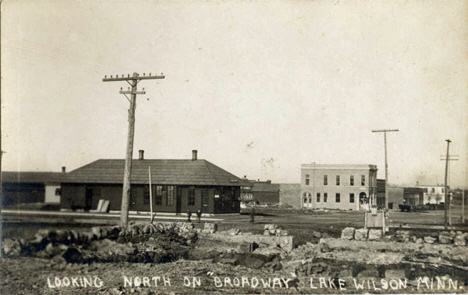
Business on Broadway Avenue, Lake Wilson,
Minnesota, 1912
Courtesy
Murray County Historical Society
and Minnesota
Reflections - click image to enlarge
The town came back with a real bang. For years its Farmer's Day
celebrations were the leading sporting event in this section. People
flocked here to see good baseball. And what good baseball teams we
had! Besides the county teams, there was the best in this section of
the state. Here John Donaldson, negro player and greatest pitcher of
all time, either black or white, strutted his stuff with the All
Nations, and then there were the Sioux City Packers when they were
in their prime, the Raggedy Tennessee Rats, Gilkerson's Union
Giants, a team that had more power than any other colored team that
made this section, the Flandreau and Pipestone Indians, Estherville
and Spencer, Pipestone and Marshall. Calling the names of the teams
who played here in those balmy days would include the name of every
better team in this section of the state, South Dakota or Iowa. The
management always had this thought: get the best.
Those early "Farmer's Days" were the "Golden Era" for this
section. There was the community spirit that comes to the builders a
community, and the farmers in this vicinity joined in to help make
these big days a success. They were just as proud of the Farmer's Days
as the folks in town. Baseball was not everything on the program.
There was always a topnotch speaker, good bands; then there were
prizes for the best buggy team, the best single horse, best draft team,
horse races, tugs-of-war and all kinds of minor sports. The first
airplane to take to the air in Murray County took off at one of the
"Days." Then there were the foot races for the men, boys and girls,
some good free acts and the day ended with a big dance in the
evening. All the ladies aid societies had eating stands. In fact
everybody entered into the spirit of the affair. In the winters we
had calf shows, colt shows, corn and grain shows and then there was
always the Farmers' Institute for two days, generally the two
coldest days of the winter. These were the horse and buggy days,
perhaps a bit old fashioned compared to the fast moving scenes of the
present, but they brought out the best that was in men and women.
In the '80s this was a sportsman's or rather a hunter's
paradise. Ducks, geese, brants, plover and snipe were shot from the
lake shore. The men from Maine, who came here in the employ of Wilson
in 1883, had a wonderful time. They built sail and row boats for the
lake which had 15 feet of water. When fall came the boys had a
building about l2x14 on the lake shore and it was literally filled
with brants, geese and ducks. They were shot in the freezing days of
the fall and kept until the holidays.
The first depot agent was Chas. Bragdon. J. W. Bragdon was the
first postmaster. J. W. Parshall was the first school teacher,
walking in four miles from his farm nearly every morning. Ted Humble
was the first lumber man. The first Christmas tree was a bare ash from
Bear Lake. The willows along the lake shore were planted by M. E. Lang and H. Uebesigitzig in
1884. Bill Sabin was the first man to work in Lake Wilson; he helped
dig the first cellar. The first postoffice was located on the Flannery
place west of town. The postmaster was Wm. Luce. The first religious
service in Lake Wilson was held in the third story of the big store
building. This hall was also used for dances, parties, and lodges.
Amusements were simple, consisting of literary societies, which
always included a debate, taffy pulls, dances (sometimes a one man
fiddle affair), stringing the cranberries and popcorn for the
Christmas tree, the Christmas programs, quilting bees and skating
and sleighing parties. When death came to a home, the shades were
pulled down and the neighbors in pairs, took turns in sitting up
with the corpse. The revivalist held down the school house for two
weeks and sometimes we had some of our own who soon forgot and
started chewing tobacco and cussing the minute the revivalists had
gone. We used to have a pool as to who would be the first to
backslide.
Magic lantern shows would make the town once a year and a
phrenologist would hold forth at the schoolhouse for a couple of
nights reading our heads. In the early '80s a picturesque looking
foreigner would make the rounds with a dancing bear who climbed the
telephone pole, danced and wrestled with the keeper. Hunting did not
take up much time in the fall. There were no game laws and everybody
had all the game he wanted. The lake has been dry at three different
periods (that is, completely dry). The earliest was before the '60s
(so an Indian told Hans Nelson, pioneer resident). Train service
especially in the winter was terrible. One winter in the late '80s
we had no service here from December until April. The wheat was green
in the fields by the time the train came. We got our mail and
merchandise from Chandler that winter. Bill Sabin was mail carrier.
Bids were taken for the job. When the bids were opened, Bill's bid
was ninety cents so he had the job.
When sickness came, doctors came from Slayton and Pipestone; not
very often, though, as it cost money, something we did not have to
burn.
Groceries all came in barrels or boxes, no cartons. At first
there were no paper sacks and we had to pour the sugar out on a flat piece of paper and tie it up. Everything but canned goods came
in boxes or barrels. Even the snooze was kept in a jar and had to be
weighed out by the ounce. Before the stockyards came, farmers
butchered their pigs and brought in the carcasses. They were laid on
a box and you could buy a quarter, a half or a whole hog. Dressed beef
sold for 3 to 4 cents the pound.
We had no movies, no ice cream parlors, no study club, no bridge
club, no lodges, no beer halls; yet we got by and were more
contented than we are now. The village of Lake Wilson was incorporated
June 23, 1900.
One of the staunch friends of Lake Wilson in the early days was
B. I. Weld of Slayton. He was president of the State Bank here
during the fire of 1911, and when plans were being drawn for the new
bank building a majority of the directors were in favor of erecting
a one story building. Mr. Weld, however was insistent that the new
building should have two stories and finally won his point. Ever
since the bank was built the upper story has had a tenant. In many
other ways the late Mr. Weld lent his aid and assistance to Lake
Wilson and his help was duly appreciated by the folks who knew and loved
B. I.
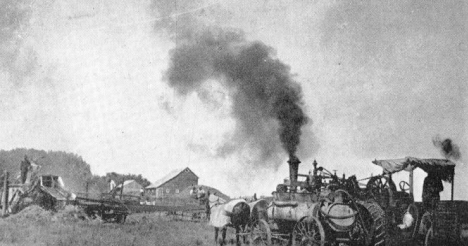
"In the Days of Steam"
BATHING IN LAKE WILSON IN in 1910
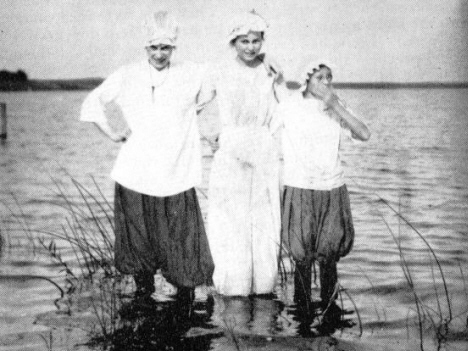
Latest styles in bathing costumes that season. One of the ladies is
now the wife of a well known Chanarambie Twp. farmer
Another Slayton man who was always a sincere friend of Lake
Wilson was the late Senator J. V. Weber. Vin started coming to Lake
Wilson in the early Farmer's Days. He used to sell wienies, and he
made good at that, as he did in everything he tried. He was always
willing and able to aid us in every undertaking. Spoke here on
Commencement Days and Decoration Days, in fact, whenever we were in
need, we called on "Vin" and he never failed us.
The title of most successful man in the history of Lake Wilson,
no doubt, goes to L. J. Kaplan. He came to Lake Wilson in 1920 and
started up a store on a meagre line of merchandise. The goods were
all right but they were few and far between. He and his wife,
Sylvia, buckled down to work and put the old Engebretson store building into shape. The man and his wife had some
experience in dry goods. They soon expanded, moving into the
building north of the State bank. Here they grew and prospered.
Louie had everything in the sales line. He bought flour, peaches,
apples, salt, etc. in car load lots and his trade increased far
beyond the Lake Wilson territory. His success here attracted buyers
and the Kaplans sold out here and moved into Iowa.
Locating in Storm Lake, he operated a chain of stores throughout
Iowa and southern Minnesota, and branched out into the wholesale
grocery business while residing in Storm Lake.
They moved the wholesale business to Sioux City, Ia. and expanded
their retail stores.
In 1929 they adopted a four year old girl, Doris, and in 1932 a
son, Jay, was born to them. Doris was married in August, 1944, to
Allan H. Rolfe, of Minneapolis, Minnesota.
Louie never lost the human touch for his Lake Wilson
friends—something that is greater than fame or honor.
BASEBALL "CAME" TO LAKE WILSON IN "GAY NINETIES";
Baseball as it was played here in the late eighties was a pretty
crude sport. We used to play in the pasture just south of the Bobbie
Smith home. Bill Mooney, who lived over in Leeds twp. was an ardent
baseball fan. He came from Iowa. Bill asked his nephew Hugh Mooney
to come and visit him. He was a curve ball pitcher and a good one.
We were playing the Sod Grabbers that day, a team from over Buffalo
Ridge way, and a quaint bunch they were. The town lads were decked
out in pants of blue, yellow and scarlet. The Grabbers wore overalls
and their catcher had feather beds for mitts. He had one for each
hand, big affairs they were, stuffed with chaff and feathers. When
he caught the ball he had to stop and take off one mitt and then the
other, and by that time the runner, like Greenberg, was on third.
Hugh fairly stood the Grabbers on their heads. They were bowing and
bending like a head waiter at his curves and the score ended 67
to 3 in favor of the curve ball. Hugh is a cousin of Ed. Scully of
Hadley. Bill Mooney still lives at Waverly, Iowa.
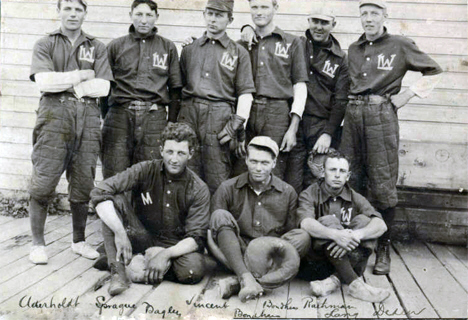
Lake Wilson "Cottonsox" baseball team, Lake
Wilson Minnesota, 1909
Courtesy
Murray County Historical Society
and Minnesota
Reflections - click image to enlarge
CHURCH HISTORY OF LAKE WILSON
THE GERMAN EVANGELICAL CHURCH
The first church in Lake Wilson was the German Evangelical. It
was organized in 1898 by Rev. Hahlen. Among the organizers were the
Theo. Roeseler, Fred Kuist, Julius Nepp, Otto Bauman, Carl Rickgarn,
Robert Koplein and J. Plambeck families.
Services were first held in the old schoolhouse. Then a small
church was built. With the coming of other churches the membership
began to dwindle and the church was sold in 1920 to the members of
the Catholic church.
THE LUTHERAN CHURCH
The Lake Wilson Lutheran church was organized at the old school
house in Lake Wilson on the evening of April 17, 1903, the Rev. L.
O. Fossum of Slayton acting as chairman of the meeting. The Lutheran
Christians in and around Lake Wilson organized by adopting a
befitting constitution in which
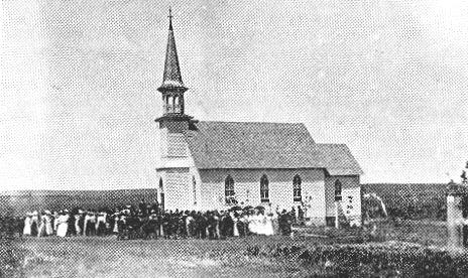
Dedication of the First Lutheran Church in September 1906
they named the congregation "The Rosendahl Scandinavian
Evangelical Lutheran Congregation of Lake Wilson, Minn." Martin
Westwick was secretary and Peder Engebretson was treasurer of the
meeting. Andrew I. Olson, T. T. Bondhus and Peder Engebretson were
selected as trustees. The trustees also served as deacons. Rev.
Fossum was the first pastor; he was installed July 11, 1933. The
charter members were Peder and Turena Engebretson, and Hervida,
Lawrence and Mamie Thorbjorn, Margretha Bondhus, and John, Gunnar,
Herman. Zella, Martin, Arent, Thorn, Lars, George; Thorvald and
Cecelia; Andrew I. and Lena Olson, and Bernt, Oscar, Ernest, Chester;
John and Sina Lane, and Selma, Jennie, Antoinette, Clifford; Lewis
and Lottie Tokle, and Andrew and Arthur; Iver and Mathilda Moen, and
Clarence, Carl, Mabel, Ida, Ellen; Theodore and Martin Westwick;
Lars and Jim Sande. Eight families totaling forty-six souls. Church
was held in the old schoolhouse for the first four years. In 1946
with the Rev. M. D. Hinderlie, pastor, the congregation numbered 385
souls. A missionary to China is supported in addition to many
other benevolent and educational enterprises.

An early Ladies' Aid Society at Lake Wilson
Lutheran Church
Mesdames: Jensen, Sackett. Lavalle, Osborne, Bean,
Lang, Pattinson, Paxton, Uebersetzig and Forrest
THE METHODIST CHURCH
The first preacher to visit this section was Rev. Stockdill of
Windom, an itinerant preacher who made visits to the outlying
districts in this section of the state. He came on horseback, and
the first services held were at the home of Elder Phelps in
Chanarambie township. There was no Methodist organizationin Lake
Wilson until 1907 when Rev. Ellis effected an organization. The
members purchased the old schoolhouse for church purposes. Here is a
list of the names of the members who organized the church: Mr. and
Mrs. H. W. Anderson, Alex, Henry and Helen Anderson;Mr. and Mrs. A.
L. Partridge and son, Ivan;Mr. and Mrs. G. O. Balcom;Mr. and
Mrs. A. J. Osborne, Eunice and Rowena;Mr. and Mrs. M. H. Blood and
Ruby;Mr. and Mrs. O. G. Grier and family;Mr. and Mrs. L. L.
Grier and family;Mr. and Mrs. F. L. Sackett;Mrs. J. M. Ganschaw;
Herbert and Blanche Sackett;Mrs. R. D. Sprague and Dora;Mrs.
Sadie Triplett and Eva.
THE CATHOLIC CHURCH
The Catholic church was organized in Lake Wilson in 1916. The
members who took part in the organization of the church were Mr. and
Mrs. Gasper Goeppel,Mr. and Mrs. Carl Manderscheid,Mr. and Mrs.
Henry Nett,Mr. and Mrs. Joseph Nett,Mr. and Mrs. Herman Nett,
Mr. and Mrs. Casper Rademacher,Mr. and Mrs. Michael P. Flannery,
Mr. and Mrs. E. W. Hook,Mr. and Mrs. Fred Berreau, Mr. and Mrs.
Phil Flannery. The first mass was said by Father O'Regan of Slayton.
The church property was purchased from the German Evangelical
organization.
THE LAKE WILSON COOPERATIVE ELEVATOR AND LUMBER COMPANY
No history of western Murray County would be complete without the
story of the Lake Wilson Co-operative Elevator & Lumber Company, the
heaviest local taxpayer in Murray County.
The unsatisfactory prices paid for grain in the early 1900s
brought about the organization of the Lake Wilson Co-operative
Elevator. This institution was started Feb. 18, 1905, when a notice
was placed in the Pilot asking all farmers who were interested in a
farmers' elevator to meet at Brekke's hall on March 4th.
A. I. Olson was elected temporary chairman and Philip Flannery
temporary secretary. After a discussion of grain market conditions
in Lake Wilson the meeting was adjourned until March 11, 1905. At
this meeting, the following officers
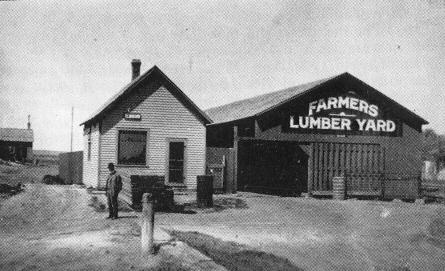
The Lake Wilson Farmers Co-op Elevator &
Lumber Company, 1914
This is the first office. lt was taken in 1914
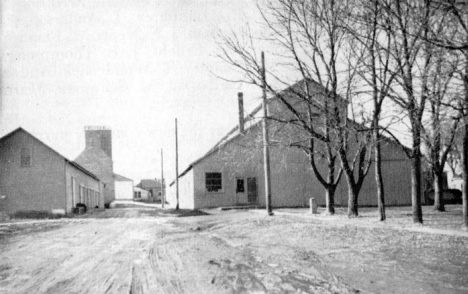
The Lake Wilson Farmers Co-op Elevator &
Lumber Company, 1946
This is a view taken in 1946. Buildings are so
crowded that it is impossible to get all the buildings in one picture
were elected: President, A. I. Olson; Vice Pres., L. Triplett; J.
J. Mihin, Treasurer; and George Vallance, Secretary. At this meeting
$4,000.00 was pledged. A motion was passed that the sharesbe $25.00
and the limit placed at four to a member, who was allowed only one
vote. The directors elected were John Rohde, W. S. Pattinson, S. T.
Campbell, Christ Erickson, and B. F. Warren. The officers were
instructed to prepare bylaws and a constitution.
The following is a list of the names of the farmers who purchased
shares: A. L. Olson, L. Triplett, C. Erickson, L. Tokle, B. F. Warren,
S. T. Campbell, John Rohde, George Vallance, Gust Nelson, Wm. Prahm, G.
J. Gjervold, H. W. Anderson, J. J. Mihin, Frend Kench, Wm. Scott, J. D.
Peterson, R. Harmsen, Ole Oleson, Phil Flannery, Theo. Berg, E. N.
Moore, Fred Carlson, Wm. Sabin, J. A. Johnson, O. H. WilIiams, Victor
Anderson, Martin Madison, J. Plumbeck, August Olson, Iver Erdahl, J. J.
Low, B. Erdahl, Tom Hughes, W. S. Pattinson, A. Oberg, M. E. Blood,
Theo. Roeseler, Ole Peterson, August Erickson, J. O. Gravel, A. F. Folstad, Fred Sagner, Carl
Rickgarn, N. Nissen, E. Humphrey, J. Anderson, Joe Stevens, C. L.
Bangson, Otto Bauman, J. F. Nepp, M. Flannery, H. Brummer, Tom
Flannery, O. Erdahl, J. E. Thompson, J. Knaach, A. L. Partridge, G.
Country, T. Wunderlick, Andrew Edmundson, Fred Gass, Ole Halbostad,
M. Schwartz, Martin Forrest, Otto Heimness and B. O. Gravely.
On June 2nd of the same year the new company purchased the
Hubbard & Palmer elevator.
A four bin coal shed was built in the fall. Here was the Lake
Wilson Farmers' Co-operative Elevator Association born, and not a
member at that time ever dreamed that it would become the largest
institution of its kind in Murray County. In commenting on the new
organization the Pilot of March 25 said, "Not one of the stockholders
needed security or additional signers on their notes"—something
unusual in those days.
The history of the organization has been one of progress and
expansion. In 1914, three years after the disastrous fire, the
members purchased the M. E. Lang lumber yard. More buildings were
erected, including a seed and feed shed, and they carry a complete
line of every variety of seed as well as a substantial stock of feeds
for livestock, including poultry.
A modern coal shed was erected which is one of the best in this
section. Naturally the company has had its ups and downs; there were
years when the profits were exceedingly low, the lumber yard one
year not showing a cent profit.
The officers who direct the policy of the association today are:
Gilbert Erickson, President; Leslie Oberg, Vice-President; John
Tutt, Treasurer; Oscar Olson, Secretary; and Directors, Henry Anderson,
Fred Heins and Gunder Bondhus.
In charge of the company operations are: Willis F. Godfrey,
General Manager, who has been with the company since 1939, and Rudy
Brummer, Assistant Manager of the lumber yard, and Frank H. Nett,
Assistant Manager of the grain department. These two men joined with
the company in 1939. Two of the men, Godfrey and Brummer, were in the
navy during World War II.
THE FIRST NATIONAL BANK OF LAKE WILSON, MINN.
In the development of this community the First National Bank has
played its part.
This institution was organized in 1919 and during the last
twenty-eight years has played an outstanding part in every phase of
the steady improvement and the security of this section of Murray
County.
The bank was opened on August 19th, 1919 with the following
officers: President, John W. Erickson;vice president, A. G. Lane; J.
M. Collins, cashier; Henry Groskreutz, assistant cashier and Ole
Halbostad, Fred Carlson and C. E. Zeiner, directors.
During the depression period this bank like hundreds of others in
this section was strained to the utmost. Bank after bank was closing
its doors but the First National kept its doors open and its credit
good. It was the only bank in western Murray County to weather the
financial storm. While the bank officials were criticized at times for being too conservative,
the policy of the institution proved to be a sound one.
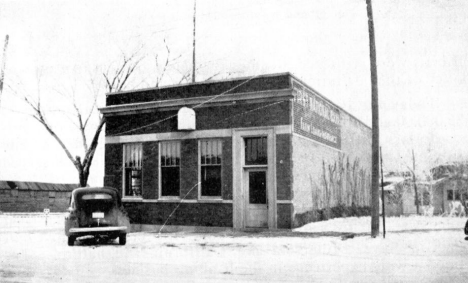
The First National Bank of Lake Wilson, Minnesota,
1919, erected in 1919
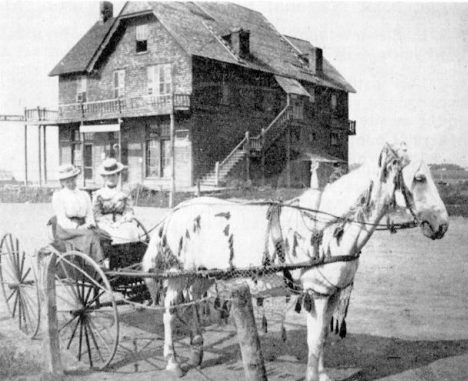
This is the old store building erected by J.
E.Wilson, in 1883.
It was the first hotel, first store, first Post office, first
church, etc. It stood on the plot of ground now occupied by the bank
Today the bank that started with a capital amounting to
$25,000.00 and $5,000 surplus, now has footings of over one million
dollars and a reputation for soundness not exceeded by any bank in
Minnesota. In 1947 Glen A. Swenson who had served the bank for nearly
twenty-five years, sold his interests to H. R. Lexvold.
Mr. Lexvold, who was born in Center Point, Iowa, has been
associated with banks all of his adult life being employed in banks
in Iowa, Minnesota and California and naturally has gained a wide
experience in the banking business.
For some time he has been anxious to enter the banking business
in southwestern Minnesota and in a town where he could make his home and he feels well satisfied with the town and
the people in the community and the village.
Mr. Lexvold was united in marriage to Miss Marion Lilland of
Estherville, Iowa. They have two children, Roger and Shirley.
Assisting Mr. Lexvold in the bank are R. E. Meyer, formerly of
Mountain Lake, Minnesota and Miss Margaret Anderson of Lake Wilson.
The officials of the bank are: President, Albert Amundson; vice
president, H. R. Lexvold; directors: Mrs. B. O. Clauson, C. F.
Lentz, and Henry Anderson, and H. R. Lexvold, cashier.
From A HISTORY OF WESTERN MURRAY COUNTY
from 1688 to 1946
by Robt. B. Forrest, published in 1947
|
|





